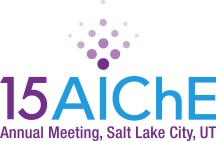
- On November 10, 2015, in a session titled “Intelligent Decomposition: Product Design and Ontologies” and sponsored by CAST, paper 408e, authored by L. KOO, F. CECELJA and N. TROKANAS, discussed “Ontology Engineering Approach to Support Process Model Integration“.
The authors, researchers from University of Surrey, state rightfully that ” CAPE-OPEN addresses the issue of standardisation of interfaces to enable interoperability between simulator software components from different sources“.
However the authors appear to limit the middleware through which CAPE-OPEN can be implemented to the Common Object Request Broker Architecture (CORBA). More truly, in most cases where CAPE-OPEN is implemented and used, it is through COM middleware, reflecting the fact that most process simulation software are running on Windows platforms.
They further state that “the shortcoming of the CAPE-OPEN is in the need for identifying key variables for each unit operation“. For CO-LaN there is no such shortcoming. CAPE-OPEN was made to achieve interoperability between process simulation software. As such the granularity used by CAPE-OPEN is rather coarse: a Unit Operation, a Property Package. For example, there is no attempt by CAPE-OPEN to standardize the names of parameters carried by a Unit Operation or a Property Package. Hence there is no semantic value given to any parameter.
Further on, the authors “propose an extension of classification of variables defined by CAPE-OPEN with adaptation to ontology.” They define the concept of device (e.g. unit operations, flowsheets, subflowsheets etc.) which is semantically described by the domain ontology. “The devices in a process are connected via streams that transmit information through multiple inlets and outlets from one unit to the other. The connections between devices are described in ontology by introducing the concept of Ports and connections” as per CAPE-OPEN concepts. They also state that “The structural concept and classification of matching parameters defined by CAPE-OPEN have been employed in ontology.“
So their work build on some of the main CAPE-OPEN concepts.
- On November 11, 2015, Patrizia MARCHETTI, from Imperial College London, presented on “Membrane transport and process modelling in OSN: a multiscale approach” (paper 155D).
The paper reports a systematic comparison of different transport models using selected experimental data for various solutes, solvents and membranes. MATLAB routines for the relevant models were interfaced to Aspen Plus® by means of CAPE OPEN and custom OSN unit operations for common batch and steady-state membrane processes were developed. Co-authors are Binchu SHI, affiliated to Imperial College and Evonik Membrane Extraction Technology Limited, Dimitri PESHEV from University of Chemical Technology and Metallurgy in Sofia, Bulgaria and Professor Andrew LIVINGSTON from Imperial College.
